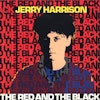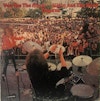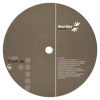For most people who aren’t music journalists or musicians of a certain age, conversations about Talking Heads usually center on the creativity of geeky lead singer David Byrne. Long thought to be the mastermind of the quartet, the aural auteur behind the group’s 1977 debut disc and masterworks Fear of Music (1979) and Remain in Light (1980), Byrne has been treated as though he were the white-male equivalent of Diana Ross while the supreme band were seen as merely backing players. Of course, nothing could be further from the truth. Bassist Tina Weymouth, drummer Chris Frántz, and keyboardist/guitarist Jerry Harrison were all musically inclined brainiacs with their own ideas of good music.
Harrison, who, unlike the others, didn’t attend the Rhode Island School of Design, was the last to join the band. A former member of Jonathan Richman and the Modern Lovers, who broke up in 1974, Harrison was enrolled in Harvard University’s architecture program when Frántz found him. Harrison was interested, but didn’t join the band until the Heads signed with Sire in November 1976. While their debut Talking Heads: 77 showed the world why they were downtown darlings down with the punk/new wave CBGBs clique, as they matured, the Heads weren’t ashamed to incorporate various types of music (soul, funk, Afrobeat, disco) to create their daring sound.
During early interviews and features, the Talking Heads were presented as equal partners in their house of music, but by the time the Brian Eno–produced discs Fear of Music and Remain in Light came out, Byrne was viewed by the general public as the group’s genius leader. However, one listen to the Head’s receptive solo albums should have put a halt to any loose talk about their contributions to the band’s sound.
In 1981, they all released evocative solo albums. Byrne teamed up with Eno and released the brilliant My Life in the Bush of Ghosts. Married couple Weymouth and Franz christened themselves Tom Tom Club and released a funky, hip-hop-inspired debut that contained the classics “Wordy Rappinghood” and “Genius of Love,” a track that itself became an archetypal hip-hop groove and has been sampled by many artists including Mariah Carey, Redman, and 2Pac. Still, while the tape-looped Bush and head-nodding Tom Toms built a cultural monument no one could ever tear down, Jerry Harrison’s The Red and the Black isn’t a part of any musical discussion simply because so few know that it exists.
Hell, even back in the ’80s when I found the disc in the dollar bin of Sounds Records on St. Marks Place, I never heard any reference to Harrison’s album from critics. Eventually, I discovered a Robert Christgau dis, while years later AllMusic published the only rave I’ve seen about The Red and the Black, an album Harrison recorded at the infamous Blank Tape Studios. Owned by Bob Blank and located at 37 West Twentieth Street, the studio was where James Chance, the B-52s, Arthur Russell, and Kid Creole and the Coconuts recorded, and was known for its quality sound but charged cheaper rates than their Midtown counterparts. Many innovative projects were recorded at Blank Tape, and The Red and the Black stands proudly beside them as an Afrobeat funk effort that was simultaneously streetwise and surreal. Harrison’s voice is as strange as Byrne’s, but looser and more playful as though he was the cool uncle while David was the uptight daddy.
Remain in Light was The Red and the Black’s big brother, and they shared a creative roster that included P-Funk keyboardist Bernie Worrell, guitarist Adrian Belew, and former Labelle vocalist/songwriter Nona Hendryx, who cowrote the funky “Magic Hymie,” a track that opened with a thick bass line courtesy of George Murray, best known for his work with David Bowie. Much like Bowie and Byrne, Harrison had no problem mixing genres, flipping from avant-pop to knee-deep Blackness often in the same song. Harrison reminds me of a character from a Jim Jarmusch film, a dude living on Avenue B and walking the streets of the Lower East Side while hearing all types of music and later putting those boombox-stereo experiences into his own music.
Opening The Red and the Black with African drumming that feels like a juicy kiss from the Motherland, the track “Things Fall Apart” was named after a book by Nigerian novelist Chinua Achebe—but could’ve also described the fragile state of the Talking Heads at that point in the band’s history. In the studio, the drums were slowed down as Belew crashed through with his expressively arty riffs and creepy guitar effects. Next to Prince, Vernon Reid, Jean-Paul Bourelly, and Slash, Adrian Belew was among my top five of guitarists in the ’80s, and on The Red and the Black, he really struts (and strums) his stuff. He can hang with the dance grooves of “Slink” as well as the ambient dub of “The Red Nights” to the gritty love song “No More Reruns.” One of the album’s standouts, “Worlds Collide,” had lyrics that sounded like J.G. Ballard–inspired poetics while Harrison layered strange synthesizer noises, feedback, and found sounds creating a futuristic musical tapestry.
Polyrhythmic, progressive, and phat as hell, The Red and the Black was a journey into Jerry Harrison’s vast artistic vision as well as expansion of the ideas he and the other Talking Heads members had developed as a collective. Two years later, after they each got that solo stuff out of their systems, at least for a while, the Talking Heads regrouped and released 1983’s Speaking in Tongues, their most successful album. Though Harrison would release two other solo albums, Casual Gods (1988) and Walk on Water (1990), neither was excitingly experimental or as “on the one” as The Red and the Black.


